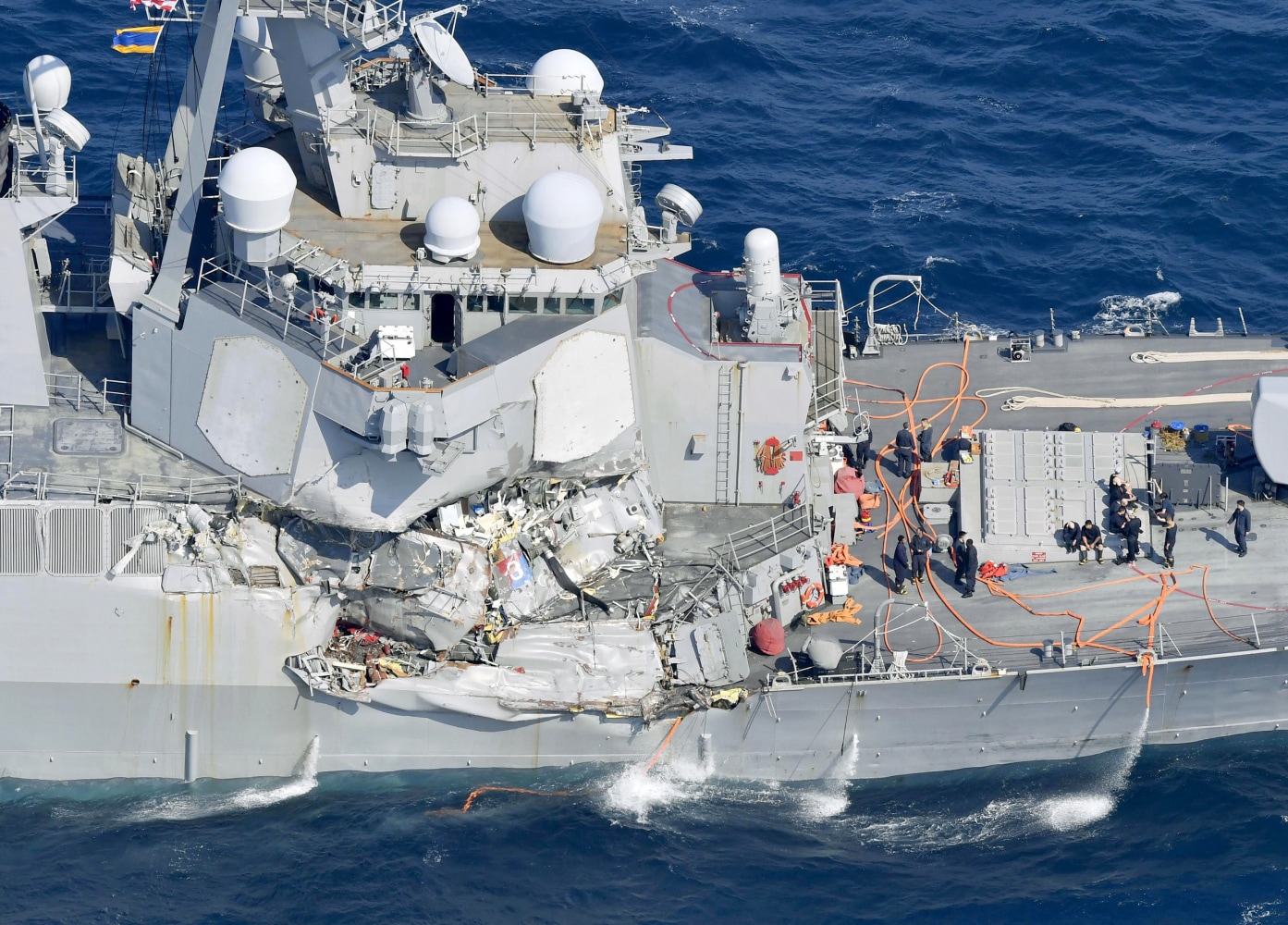 |
| Apparently, the interior of the Fitzgerrald skipper's stateroom is visible in this shot. Good grief. |
Risk assessment is more than reading a forecast or watching a radar's guard zone. It's a holistic, ongoing appreciation of what all sorts of inputs are saying while one is in command (or crewing) on a boat, including the harder ones to quantify, like gut checks or the smell of the air. It's too early to speculate on the precise chain of events that led to the recent incident involving a container ship that killed seven sailors on the U.S. destroyer Fitzgerald, depicted above, but even the already-known facts are reminiscent of the way another U.S. Navy ship, Guardian, managed to ground itself in 2013 on a charted reef (even if the charts were known to be predictably inaccurate), which led to a total loss. Ironically, considering the ecological damage done, the last biggish vessel to ground on this reef belonged to Greenpeace in 2005. Incorrectly, in my view, they also blamed the chart.
 |
| Minesweepers are made of wood, so a few weeks on coral... |
 |
| ...precludes a buffing-out. |
Our tools, in this case, our navigational tools, are not ourselves, or, to put it another way, they are not extensions of ourselves. While it is not always possible (think of a submarine at depth) to lay physical eyes and ears on our surroundings, to put more emphasis on representations of said surroundings, rather than going outside of the glass bridge to have a look-see, would seem imprudent.
Despite the as-yet absence of a full investigation (which, like the one that dissected the USS Guardian incident, may be redacted or opaque with naval jargon), a lot of mariners have discussed this incident as it features some fairly clear-cut premises on which modern civilian and military ships operate. Particularly hard-to-turn, unhandy and comparatively slow cargo vessels and agile, fast naval ships bristling with detection gear. As this article sums up, avoiding collisions is a shared responsibility, but U.S. warships are not supposed to be crept up on by 750-foot container ships.
How agile? This agile. This is the same class of destroyer as USS Fitzgerald.
If, as is customary, both ships were on autopilot, that doesn't get anyone off the hook, of course, as this more in-depth article suggests. The consequences are real and are, of course, tragic. While we think of warships as intrinsically strong, they are merely strong enough; if you want speed, you can't build a ship with 30 cm. thick sides. Most modern naval warfare involves missiles at a distance and countermeasures to missiles at a distance, not ramming. I cannot imagine what went through the skipper's mind as he was (apparently) nearly ejected from his ship. What is known is that it was a new gig for him.
 |
| Physics has the final word, again. |
Even in the seaways with the most heavy use and the arguably most closely monitored traffic separation schemes (TSSs), the scourge of under-crewing and lax watch standards can cause ships to collide. Again, this is a recent (July 1, 2017) event, but I will wager that someone who should have been looking around wasn't, or was beguiled by a screen. Makes sense in such circumstances to avoid ships entirely if they exhibit zombie-like behaviour, doesn't it?
 |
| Yes, the struggle is real. |
Back in the small-boat realm, I just read a rather good article (in which the writer, rarely in my experience, seemed to have sailed and knows what a sailor would care to know when reading about a bad day on the water) on a heavy squall that hit a post-race group on Mobile Bay, Alabama in the spring of 2015. The description in the article make it clear that a host of factors led to tragic outcomes, but a few people chose not to race that day. The technology didn't fail those who did choose to race, but perhaps their instincts faltered. I can't make that judgment, frankly, and it would be hubristic to try. But I have noticed that a) people rely a great deal on technological inputs while sailing (readers may recall we ourselves recently updated our plotter) and b) the traditional skill sets of the sailor are beginning, I would argue, to wilt. Who sails today with just a handheld VHF and maybe a bulkhead compass? Perhaps the lack of screens might sharpen some skills that may be shown, once again and sadly, to be absent on some of the largest and most-crewed vessels on the oceans.
UPDATE, 17.07.15: Receent shots from the drydocking of the USS Fitzgerald suggest why crew died and how it was very fortunate that this ship did not go to the bottom: https://news.usni.org/2017/07/12/new-dry-dock-photos-show-extent-hidden-uss-fitzgerald-damage




